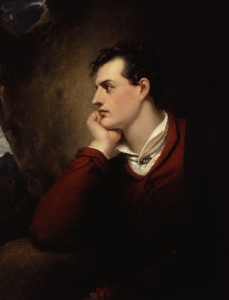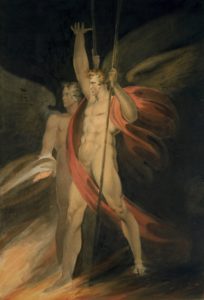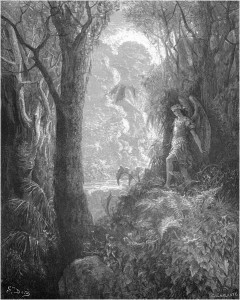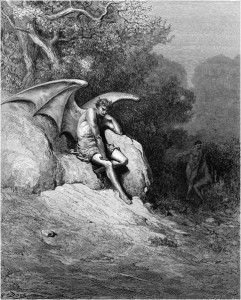“…Satanism is associated with that hard core of romanticism which can only be called hubris—the will to be God—the will to arrogate to the individual and finite mind those attributes traditionally reserved for God alone: self-sufficiency, creativity, and ultimate freedom from all moral law.”1
— Peter L. Thorslev, Jr., “The Romantic Mind Is Its Own Place” (1963)
As discussed in part one, Romantic Satanism—the grand and groundbreaking phenomenon within which Lucifer, as reimagined and immortalized by Milton in Paradise Lost (1667), was most lauded—has received little more than lip service within organized Satanism over its half-century span, starting with Anton LaVey’s Church of Satan in 1960s San Francisco. The tellingly insecure insistence of most organizational Satanists that Satanism is entirely unprecedented has led to the snubbing of the Romantic radicals known as “Romantic Satanists.” Yet LaVeyan Satanists are not alone in calling into question the Satanic legitimacy of Romantic Satanism, truth be told, for academics are prone to a similar skepticism. While Satanists have tended to ignore Romantic Satanists in an effort to secure their own Satanic hegemony, academics have demonstrated a predilection for downplaying the significance of the Satanic strand of Romanticism, ironically citing the same reason as Satanists proper: the Romantic Satanists were not real Satanists. These doubting academics, however, invariably end up demonstrating just how Satanic the Romantic Satanists were.
Romantic Satanists: The Unacknowledged Legislators of Lucifer’s Legacy

In his 1968 essay “The ‘Satanism’ of Blake and Shelley Reconsidered,” Joseph Anthony Wittreich, Jr. argued that Romantic Satanism is a grossly exaggerated phenomenon. When venturing into the etymology of the terms “Satanist” and “Satanism,” however, Wittreich inevitably illustrated the fact that Southey’s “Satanic School” diatribe against Byron and Shelley2 for the first time in history employed the “Satanist” stigma most appositely, i.e., against actual Satan sympathizers.3 For a more recent example, consider Peter A. Schock’s definition for “Satanism” in the Encyclopedia of Romanticism: “The Romantic perspective on Satan is so complicated and qualified that no writer of the age could be considered a true ‘Satanist,’ ” Schock writes, explaining, “No one individual thoroughly idealized Satan or identified this closely with the figure: there was no ‘Devil’s party’ in the Romantic era.”4 This greatly overlooks Romanticism’s many “true Satanist” moments. To say that no Romantic idealized Satan is to overlook, for instance, both Byron and Shelley’s applause for Satan as the Promethean “hero of Paradise Lost,”5 Shelley’s bold assertion that “Nothing can exceed the energy and magnificence of the character of Satan as expressed in Paradise Lost,”6 or Hazlitt’s celebration of Milton’s Satan as “the most heroic subject that ever was chosen for a poem…”7 To say that no Romantic identified with Satan is to overlook Shelley’s professed longing to be the (Miltonically conceived) Antichrist8 and Byron’s fantasies of himself as a fallen angel.9 There may not have been an actual “Devil’s party” or a “Satanic School” during Romanticism, but the phrases themselves belong to the period, and they could not have been more appropriate.
“Devil’s party” was coined by one of Romanticism’s most important figures, William Blake, who in The Marriage of Heaven and Hell (1790–93) famously theorized: “The reason Milton wrote in fetters when he wrote of Angels & God, and at liberty when of Devils & Hell, is because he was a true Poet and of the Devils party without knowing it[.]”10 Blake’s witticism clearly establishes that there is a tradition—reaching back to Milton—into which Blake places himself and his fellow “true Poets,” and it is a tradition of an unbounded artistic genius that can only be considered Satanic. (“…I was walking among the fires of hell,” Blake writes in The Marriage, “delighted with the enjoyments of Genius; which to Angels look like torment and insanity.”11) Yet “Devil’s party” also suggests a political aspect to Blake’s conceived tradition: Satanic partisans enlisted in the cause of republicanism, hence Blake’s co-opting the regicide-defender Milton.

Some two decades after Blake’s Marriage, Shelley would quite explicitly forge a Satanic political link in A Declaration of Rights (1812), his own clarion call for Man to assert his proper worth and rise from lowliness and degeneracy to loftiness and dignity. The dramatic finish to Shelley’s exhortation reads, “Awake!—arise!—or be forever fallen,”12 which of course is the concluding line of the impassioned speech with which Satan rouses his fallen compatriots from Hell’s burning lake in Paradise Lost (I.330). Shelley thus imagines oppressed peoples as fallen angels, casting himself as Milton’s Satan, whose “heart / Distends with pride” at the sight of his fallen but reassembled brethren, who are promised, “this Infernal Pit shall never hold / Celestial Spirits in Bondage…” (I.571–72, 657–58).
Lord Byron moved beyond employing the fallen archangel as a symbol of artistic expression and political indignation, taking the idealized Devil into the arena of existential philosophy. In Cain: A Mystery (1821), Byron cast Lucifer as a genuine light-bringer, in the Promethean sense—promoting knowledge as liberation from divine authoritarianism—and the Byronic Lucifer’s enlightenment of Adam’s firstborn son radically reassesses the so-called Fall of Man:
One good gift has the fatal apple given—
Your reason:—let it not be over-sway’d
By tyrannous threats to force you into faith
’Gainst all external sense and inward feeling:
Think and endure,—and form an inner world
In your own bosom—where the outward fails;
So shall you nearer be the spiritual
Nature, and war triumphant with your own. (II.ii.459–66)

Lucifer’s parting words of wisdom to Cain “declare a commitment to intellectual freedom that has never been surpassed in English verse,” insists Byron scholar Jerome J. McGann,13 and it is no small thing for such an eloquent expression of mental emancipation to be placed in the mouth of the Prince of Darkness; indeed, it Satanically reevaluates him as a true Light-Bearer, hence Byron’s restoration of his native name, Lucifer.
Satanism permeates the lives and the literature of those Romantic radicals who’ve been rightly referred to as “Romantic Satanists.” One simply cannot overstate the significance of these Romantic titans irreverently upending Christendom’s foundational myths and scandalously celebrating the Satanic with such spirited artistic expression. Much to Schock’s credit, despite his leading qualification of the legitimacy of the Romantic Satanists’ Satanism in his Encyclopedia of Romanticism entry quoted above, Schock immediately proceeds to appropriately stress the significance of the Romantic preoccupation with Satan:
Nevertheless, many Romantic writers and artists were absorbed with the myth of Satan: the persistent fascination with the Devil evident in their work amounts to Romantic myths of Satan. In new or renovated guises, the figure of Satan looms large in the writings of Blake, Byron, and the Shelleys and appears in the work of many other English and continental writers, painters, and popular artists. Nearly rivaling Prometheus as the most characteristic mythical figure of the age, Satan assumes a prominence in the Romantic era never exhibited before or since.14
The momentousness of the Romantics raising the fallen angel to such a prominent position—essentially setting the erstwhile “Adversary of God and Man” (PL, II.629) shoulder-to-shoulder with the champion of Man found in the humanitarian Titan Prometheus—quite simply cannot be overstressed. In Romantic Satanism, the only book-length study of the subject, Schock would go on to thoroughly demonstrate how and why “the reimagined figure of Milton’s Satan embodied for the age the apotheosis of human desire and power.”15
Satanic Academics
While real Satanists have failed to give the Miltonic-Romantic Devil his due over the past five decades organized Satanism has enjoyed, and while literary academics have exhibited a tendency to downplay the monumental significance of Romantic Satanism, the past decade or so has proven to be a shifting point in Satanic scholarship. Within the culture at large, Satanism had previously been either dismissively derided as adolescent, and therefore essentially harmless, or—as was the case at the height of the 1980s Satanic Panic launched by doomsday preachers and opportunist media personalities—virulently attacked as a major threat to Western civilization. Either way, academics were for the most part content to ignore the matter altogether, but today Satanism is the subject of increasingly serious academic studies. “Recent works of preponderantly young scholars have given this field of research an important impetus toward maturity,”16 astutely observes Ruben van Luijk in Children of Lucifer, the most recent and most significant of these new Satanic studies. These “young scholars”—namely Jesper Aagaard Petersen, Per Faxneld, Asbjørn Dyrendal, James R. Lewis, and of course van Luijk himself—might best be called “Satanic academics,” for their scholarly work vindicates Satanism as not only a serious study but also an overall positive pursuit. (Van Luijk, for instance, intertwines the historical Satanic tradition with what he collectively refers to as the Western Revolution.17) Most importantly, at least as far as The Satanic Scholar is concerned, by forging important links to Satanism’s literary and cultural heritage—chiefly the Miltonic-Romantic tradition18—these Satanic academics have succeeded where real Satanists have failed.

A cogent example of the missed opportunity of Satanists to place appropriate stress on Satanism’s rich historical and literary lineage is Chris Mathews’ Modern Satanism: Anatomy of a Radical Subculture, an academic assault on the Satanism movement. While Mathews is extremely critical of Satanism in general (“crypto-fascist ideology…intellectually, scientifically, and morally bankrupt”19) and of LaVey in particular (“a rather poor terminus for the rich literary and philosophical traditions he drew on”20), the first two chapters of Modern Satanism are devoted to noteworthy investigations of Satan’s evolution in religious and literary history, respectively. What’s more, Mathews, when defining Satanism for the reader, makes clear links to the Miltonic-Romantic tradition; for example: “Shorn of all theistic implications, modern Satanism’s use of Satan is firmly in the tradition that John Milton inadvertently engendered—a representation of the noble rebel, the principled challenger of illegitimate power.”21 Something is obviously wrong when Satanism’s detractors are more likely to give due attention to Satanism’s cultural roots—and thereby provide a more satisfying description of Satanism—than real Satanists.
Romantic Literature as Satanic Liturgy
“Poets are the unacknowledged legislators of the World,” Shelley famously stated in the final line of A Defence of Poetry (1821),22 and this assertion held a considerable degree of truth. This of course is yet another reason why the Romantic Satanists were of far greater importance in redirecting the Devil’s destiny than those involved in modern organized Satanism are willing to give them credit for. Because the Romantic Satanists “strove to express conceptions about ultimate grounds of being and a general order of existence in their major ‘Satanist’ works,” van Luijk observes in Children of Lucifer, and given that they “were also, sometimes quite consciously, staking claims on what had formerly been considered the territory of the church,” Romantic Satanism is definitely nothing to scoff at:
It is inadequate to contest that these appearances of Satan were merely a matter of literature. Literature was a matter of religion for the Romantic Satanists, the place where they gave symbolic form to their deepest convictions. I think thus that we might be justified to describe these utterances as forms of bona fide religious Satanism.23
If poets were “the unacknowledged legislators of the World,” then the Romantic Satanists, despite occupying a “relatively narrow literary stratum”24 making for a “slender chain of sympathy for the devil,”25 surely were the unacknowledged legislators of Lucifer’s legacy. Academics are coming around to understanding this, and it is high time real Satanists join them in giving those Romantic devils their due.
Notes
1. Peter L. Thorslev, Jr., “The Romantic Mind Is Its Own Place,” Comparative Literature, Vol. 15, No. 3 (Summer, 1963), p. 251.↩
2. “Men of diseased hearts and depraved imaginations, who, forming a system of opinions to suit their own unhappy course of conduct, have rebelled against the holiest ordinances of human society, and hating that revealed religion which, with all their efforts and bravadoes, they are unable entirely to disbelieve, labour to make others as miserable as themselves, by infecting them with a moral virus that eats into the soul! The school which they have set up may properly be called the Satanic School, for though their productions breathe the spirit of Belial in their lascivious parts, and the spirit of Moloch in those loathsome images of atrocities and horrors which they delight to represent, they are more especially characterised by a Satanic spirit of pride and audacious impiety, which still betrays the wretched feeling of hopelessness wherewith it is allied.” Robert Southey, Preface to A Vision of Judgement (1821), quoted in C. L. Cline, “Byron and Southey: A Suppressed Rejoinder,” Keats-Shelley Journal, Vol. 3 (Winter, 1954), p. 30.↩
3. Joseph Anthony Wittreich, Jr., “The ‘Satanism’ of Blake and Shelley Reconsidered,” Studies in Philology, Vol. 65, No. 5 (Oct., 1968), pp. 817–18: “The terms ‘Satanist’ and ‘Satanism’ have historical liaisons that take us as far back as the Renaissance. During the sixteenth century these terms were used first in reference to the dissenters (1559), then the Arians (1565), and finally the Atheists (1589). By linguistic extension, ‘Satanism’ was broadened in the seventeenth century to include any devil-inspired doctrine or anyone with a diabolical disposition. Robert Southey, however, is the first to link Satanism with the Romantics, specifically Byron.…In our time, through linguistic specialization, ‘Satanism,’ with its full range of historical meanings, has come to refer specifically to the Romantic critics of Paradise Lost and more generally to those critics who evince a strong ethical sympathy for Satan.”↩
4. Peter A. Schock, “Satanism,” in Encyclopedia of Romanticism: Culture in Britain, 1780s – 1830s, ed. Laura Dabundo (New York and London: Garland Publishing, Inc., 1992), p. 507.↩
5. Lord Byron, quoted in Jerome J. McGann, Don Juan in Context (Chicago: University of Chicago Press, 1976), p. 25; Percy Bysshe Shelley, Preface to Prometheus Unbound (1820), in Shelley’s Poetry and Prose, ed. Donald H. Reiman and Neil Fraistat (New York [2d rev. ed. 1977]: W. W. Norton & Company, Inc., 2002), p. 207.↩
6. Percy Bysshe Shelley, A Defence of Poetry (1821), in Shelley’s Poetry and Prose, p. 526.↩
7. William Hazlitt, Lectures on the English Poets (1818), “Lecture III: On Shakespeare and Milton,” in The Romantics on Milton: Formal Essays and Critical Asides, ed. Joseph Anthony Wittreich, Jr. (Cleveland: The Press of Case Western Reserve University, 1970), p. 384.↩
8. See Peter A. Schock, Romantic Satanism: Myth and the Historical Moment in Blake, Shelley, and Byron (New York: Palgrave Macmillan, 2003), p. 80.↩
9. See Malcolm Elwin, Lord Byron’s Wife (New York: Harcourt, Brace & World, Inc., 1962), pp. 263, 271, 346; Benita Eisler, Byron: Child of Passion, Fool of Fame (New York: Vintage Books, 2000), pp. 13, 299.↩
10. William Blake, The Marriage of Heaven and Hell, in The Complete Poetry and Prose of William Blake, ed. David V. Erdman, rev. ed. (New York: Anchor Books, [1965] 1988), p. 35; pl. 6.↩
11. Ibid.↩
12. Percy Bysshe Shelley, A Declaration of Rights, in Shelley’s Prose: or the Trumpet of a Prophecy, ed. David Lee Clark, pref. Harold Bloom (New York: New Amsterdam Books, 1988), p. 72.↩
13. Jerome J. McGann, ed. Byron: The Major Works (New York: Oxford University Press Inc., [1986] 2008), p. 1072n.↩
14. Schock, “Satanism,” p. 507.↩
15. Schock, Romantic Satanism, p. 3.↩
16. Ruben van Luijk, Children of Lucifer: The Origins of Modern Religious Satanism (New York: Oxford University Press, 2016), p. 12.↩
17. See ibid., pp. 76–77, 323, 400–01.↩
18. See Jesper Aagaard Petersen, ed. Contemporary Religious Satanism: A Critical Anthology (Burlington, VT: Ashgate Publishing Company, 2009), pp. 11–13; Per Faxneld and Jesper Aa. Petersen, ed. The Devil’s Party: Satanism in Modernity (New York: Oxford University Press, 2013), esp. Ch. 2, Ruben van Luijk, “Sex, Science, and Liberty: The Resurrection of Satan in Nineteenth-Century (Counter) Culture,” pp. 41–52; Asbjørn Dyrendal, James R. Lewis, and Jesper Aa. Petersen, ed. The Invention of Satanism (New York: Oxford University Press, 2016), Ch. 2, “Satanic Precursors,” pp. 27–46; van Luijk, Children of Lucifer, Ch. 2, “The Romantic Rehabilitation of Satan,” pp. 69–112, and Ch. 3, “Satan in Nineteenth-Century Counterculture,” pp. 113–50.↩
19. Chris Mathews, Modern Satanism: Anatomy of a Radical Subculture (Westport, CT: Praeger Publishers, 2009), p. 205.↩
20. Ibid., p. 59.↩
21. Ibid., p. 54.↩
22. Shelley, A Defence of Poetry, p. 535.↩
23. Van Luijk, Children of Lucifer, p. 109.↩
24. Schock, Romantic Satanism, p. 2.↩
25. Van Luijk, Children of Lucifer, p. 74.↩